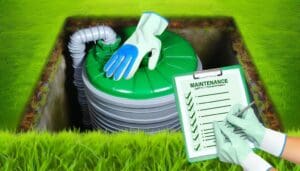Discover how to protect your septic system from breakdown with...
Read MoreYou & Your Septic Tank
Emergency Septic Pumping: What To Do When Disaster Strikes
Our professional septic service team offers comprehensive septic tank pumping services to keep your system running smoothly. Get a FREE Quote Today.

Emergency Septic Pumping: What To Do When Disaster Strikes
Imagine this: you’re hosting a backyard party, and suddenly, you notice a foul smell emanating from your yard. Panic sets in as you realize that your septic system is overflowing, turning what was meant to be a fun gathering into a nightmare. As a responsible homeowner, it’s crucial to know how to handle emergency septic pumping situations like these when disaster strikes. After all, nobody wants the embarrassment of dealing with septic issues in front of their guests – not to mention the potential health risks involved.
In this article, we’ll walk you through everything you need to know about handling an emergency septic situation while keeping safety and service in mind. From identifying the problem and contacting professional septic services to developing an emergency plan for future issues, we’ve got you covered. So sit back and relax – by the time you’re finished reading this article, you’ll be well-equipped with the knowledge needed to tackle any septic disaster that comes your way!
Identify the Problem
When it all hits the fan, recognizing the issue quickly is crucial to minimize damage and stress. Having a basic understanding of your septic system and knowing some troubleshooting techniques will allow you to identify the problem promptly so that you can take appropriate action. Problem identification starts with observing any unusual signs, such as slow draining sinks or toilets, foul odors around your property, or pools of standing water near your drain field. Remember that regular maintenance checks are essential for avoiding severe septic emergencies in the first place.
To determine if an emergency septic pumping is necessary, start by checking the most common sources of trouble. For instance, if you’ve noticed gurgling noises coming from your drains or toilets backing up when other fixtures are in use, this could indicate a blockage in your plumbing system. Try using a plunger or drain snake to clear any clogs before considering more drastic measures. Additionally, take note of whether there have been any significant changes to your household’s water usage habits – an increase in guests or newly installed appliances could be overloading your system.
If initial troubleshooting techniques don’t resolve the issue, it may be time to inspect other parts of your septic system for potential problems. Begin by examining the condition and level of wastewater inside your septic tank – if it’s full but showing no signs of structural damage or leaks, then emergency pumping may be required to alleviate pressure on pipes and prevent further issues from developing. Also check for damaged components within your tank itself (such as baffles), as these can lead to improper wastewater treatment and eventual backups.
Taking prompt action when disaster strikes is key not only for maintaining a healthy and functional septic system but also for preserving the well-being of those who depend on it daily. By familiarizing yourself with problem identification techniques and keeping an eye out for warning signals associated with emergency situations requiring immediate attention, you’ll be better equipped to serve others through proactive care-taking measures. The ability to accurately assess and address septic system issues is a valuable skill that can save time, money, and potentially even lives in the long run.
Assess the Situation and Act Fast
As soon as you notice something’s off with your septic system, it’s crucial to assess the situation and act quickly to avoid further damage. A septic backup can lead to unpleasant odors, slow drains, or even sewage overflow in your home or yard. The sooner you identify the issue and find fast solutions, the better chance you have of minimizing any harm to your property and health. It’s important not only for yourself but also for those around you who may be affected by a malfunctioning septic system.
First, determine whether the problem is localized to one area of your home or affecting multiple areas. This can help you narrow down the possible causes of the issue – perhaps it’s a clogged drain or pipe in one specific room rather than an overall septic system failure. If multiple areas are affected, check for standing water or soggy spots around your septic tank and drain field as these could indicate that it’s time for an emergency pumping.
Next, take necessary precautions to protect yourself and others from potential hazards associated with a backed-up septic system. Shut off any electrical power sources near standing water and avoid using any plumbing fixtures until the problem has been resolved. Inform family members about what’s happening so they’re aware of how to proceed safely during this time.
Once initial assessments are complete and safety measures are in place, call in professional help immediately. Do not attempt DIY fixes on a failing septic system – leave it to experienced professionals who have specialized equipment and knowledge on how best to address such issues promptly and effectively. Remember that acting fast is key: The longer a malfunctioning septic system goes unchecked, the higher likelihood there is of more extensive (and expensive) damages occurring both inside your home as well as underground within pipes and other crucial components of the infrastructure.
Contact a Professional Septic Service
When disaster strikes and you require emergency septic pumping, it’s crucial to choose a reputable company to ensure the job is done right and to avoid further damages. A reliable firm will walk you through the entire pumping process, explaining each step and providing transparent pricing to help ease your stress during this crisis. Don’t hesitate to ask questions or request references, as a professional septic service should be knowledgeable, experienced, and committed to delivering exceptional customer care.
Importance of Choosing a Reputable Company
Imagine the relief you’ll feel knowing a trustworthy and experienced company is on their way to quickly resolve your septic crisis, sparing you from potential property damage and health hazards. Choosing reputable companies for emergency septic pumping is crucial because not only are they more likely to provide reliable and efficient services, but they also have the expertise to handle any unforeseen complications during the process. Trustworthy services take pride in their workmanship, ensuring that your septic system is properly maintained and functioning optimally after their visit.
When faced with an emergency, it’s essential to have confidence in the company you’ve entrusted with resolving your septic issues. Reputable companies will be transparent about their pricing, credentials, and experience while providing excellent customer service throughout the entire process. This level of professionalism demonstrates their commitment to serving others’ needs during trying times. By choosing a reputable company for your emergency septic pumping needs, you’re not only safeguarding your property but also contributing to a community that values quality service over cutting corners or taking advantage of those in distress.
What to Expect During the Pumping Process
You might be wondering what exactly goes on during the process of having your septic tank pumped, and it’s important to have a clear understanding so you know what to expect. Being prepared for this emergency situation can give you peace of mind and allow you to better serve those around you when disaster strikes. Here’s an overview of the pumping process:
- Initial Inspection: A reputable septic pumping company will begin by assessing your septic system and determining the cause of your emergency.
- This may include locating and uncovering your tank, checking for signs of damage or blockages, and making any necessary repairs before moving forward with the pumping process.
- Pumping Process: Once everything is in order, the technician will carefully pump out all the wastewater from your tank using specialized equipment.
- This may take anywhere from an hour to several hours, depending on factors like tank size or level of waste buildup.
During this time, it’s crucial that you follow any instructions given by the technician to ensure a safe and efficient process. Keep in mind that while they are doing their best to address your emergency as quickly as possible, some issues may require additional work or even a follow-up appointment. By staying informed about each step of the process and working closely with a professional team, you’ll not only protect yourself but also contribute positively towards improving your community’s overall emergency preparedness efforts.
In conclusion: When faced with an emergency septic situation, knowing what to expect during the pumping process can help put both you and those around you at ease. By choosing a reputable company who values customer service as much as their technical expertise in this area, everyone benefits from increased safety awareness while minimizing potential environmental hazards. So don’t hesitate – reach out today for assistance if disaster strikes!
Follow Safety Precautions
In the midst of a crisis, it’s crucial to keep your wits about you and prioritize safety above all else. When dealing with an emergency septic pumping situation, there are certain safety precautions that you should take to protect yourself and others. The first step is to ensure that you have the necessary safety gear on hand, such as gloves, goggles, and protective clothing. This will help minimize the risk of exposure to harmful bacteria and other contaminants present in the wastewater.
Another important precautionary measure is to keep children, pets, and anyone not involved in the septic pumping process away from the area. Not only can they be exposed to dangerous pathogens, but they may also accidentally damage or disrupt equipment being used by professional technicians. Additionally, be mindful of any electrical hazards around your property during this time – water and electricity don’t mix well! If there’s standing water near electrical outlets or appliances, turn off power at the source if possible until the issue has been resolved.
In order to prevent further complications while waiting for professionals to arrive on-site for emergency septic pumping services, refrain from using plumbing fixtures in your home. This includes toilets, sinks, showers, washing machines – basically anything that uses water or contributes waste into your septic system. Avoiding these activities will help mitigate additional strain on an already stressed system and allow technicians to address problems more efficiently once they arrive.
The most effective way of ensuring everyone’s wellbeing during an emergency septic situation is by maintaining open communication with professional technicians throughout their visit. Make sure all relevant information about your system is readily available so they can properly assess conditions at hand – including any past maintenance records or recurring issues you’ve experienced before this event occurred. By following these essential safety precautions alongside expert guidance from trained professionals in handling emergencies like yours every day—you’ll find peace knowing that disaster has been averted while preserving health standards for both yourself and those around you.
Addressing the Root Cause of the Problem
Don’t just put a Band-Aid on the issue; it’s vital to address the root cause of your septic system woes to prevent future headaches and maintain optimal performance. Root identification is key to solving any problem, especially when dealing with something as crucial as your septic system. After you’ve followed all safety precautions and had your tank pumped in an emergency, take a step back and analyze what led to this issue in the first place. Problem prevention starts with understanding why things went awry.
Begin by examining your septic system usage habits. Are you overloading the system with excessive water use or disposing of inappropriate items down the drains? Be mindful that non-biodegradable materials, such as wipes, diapers, and feminine hygiene products can wreak havoc on your septic system. Additionally, ensure that household chemicals are disposed of properly and not poured down drains or toilets. Take note of these habits and make necessary changes to reduce strain on your septic system going forward.
Another critical aspect is regular maintenance checks for both your tank and drain field. Neglecting routine inspections can lead to undetected issues that fester into larger problems over time. These checks should include confirming proper functioning levels within the tank, inspecting baffles for damage or blockage, assessing sludge levels within the tank, and ensuring that effluent filters are clean and functional. It’s also worthwhile to examine the surrounding area for signs of leakage or overflow – lush vegetation growth near the drain field could be indicative of a problem.
By proactively identifying potential issues through routine maintenance checks and modifying usage habits accordingly, you’ll be well-equipped to prevent future emergencies related to septic systems. Remember that knowledge is power – staying informed about how best to care for your system will help ensure its longevity while avoiding costly repairs or environmental hazards down the line. So don’t just settle for addressing immediate concerns; take charge by getting to know your septic system and fostering its optimal performance for years to come.
Regular Maintenance and Inspection
Taking care of your septic system isn’t just about addressing problems when they arise; it’s also about regular maintenance and inspection to keep things running smoothly. Preventive measures can save you from the stress, expense, and inconvenience of emergency septic pumping. By being proactive with your septic system, you’re not only protecting yourself but also contributing positively to the environment and serving your community by preventing contamination of local water sources. So, let’s talk about what you need to do to maintain a healthy septic system.
- Inspection frequency: As a rule of thumb, you should have your septic system inspected at least once every three years by a professional. However, factors like the size of your tank or household usage may affect how often inspections are needed. Stay informed about the specific needs of your system.
- Pump regularly: Septic tanks require regular pumping to remove sludge buildup that can lead to backups or other issues down the line. Most tanks need pumping every 3-5 years depending on their size and usage levels.
- Be mindful of what goes in: Remember that whatever goes down your drains ends up in your septic system – be cautious with chemicals, grease, and non-biodegradable items that can disrupt the natural breakdown process or clog pipes.
- Maintain proper landscaping: Make sure rainwater doesn’t pool around or drain towards your septic area as this could cause issues with overflowing or water saturation over time.
By implementing these preventive measures for maintaining a healthy septic system, you’ll be doing more than just avoiding costly emergency situations – you’ll be actively participating in preserving our precious resources and ensuring clean water for future generations to enjoy. A well-maintained septic system is an investment in both personal peace-of-mind and environmental stewardship.
So go ahead – take charge! Be vigilant with inspections, pump regularly as needed, and be mindful of what goes into your septic system. And as you do, remember that you’re not just keeping your home running smoothly – you’re also protecting the environment and serving your community in a very important way.
Educate Yourself on Proper Septic System Use
Ready to become a septic system pro? Let’s dive into some essential tips and tricks for proper use, so you can keep things running smoothly and protect our environment. Septic system education is crucial for all homeowners with a septic tank, as it helps prevent costly disasters and ensures the long-term health of your property. By learning about preventative measures and best practices, you’ll be better equipped to avoid emergency situations that require urgent septic pumping.
First things first: know what not to flush down the drain. Many people are unaware that certain items should never go down their toilets or sinks, as they can cause damage to your septic system over time. Avoid flushing items like diapers, wipes (even those labeled “flushable”), feminine hygiene products, paper towels, grease or oils, coffee grounds, chemicals or pharmaceuticals. These substances can clog pipes or disrupt the natural balance within your tank that allows waste to break down properly.
Next up: water conservation. Excessive water usage can overload your septic tank and lead to backups or other issues. To minimize strain on your system, implement some simple water-saving measures around the home: fix leaky faucets promptly; install high-efficiency toilets and showerheads; space out laundry loads throughout the week instead of doing them all in one day; only run full loads in dishwashers; avoid using garbage disposals when possible (they contribute unnecessary solid waste). Additionally, try not to schedule multiple high-water-use activities at once – such as showers and laundry – which could overwhelm your system.
Lastly: routine maintenance checks are key! Becoming familiar with your septic system will help you notice any potential issues before they escalate into major problems requiring emergency pumping services. Regularly inspecting components like lids for cracks or damage; monitoring grass growth around drain fields for signs of leaks (green patches indicate potential issues); scheduling professional inspections every three years – these are just a few ways to keep on top of your septic system’s health. By staying informed and proactive, you’ll be well-prepared to handle any unexpected situations that arise, ensuring your home stays safe and environmentally friendly.
Develop an Emergency Plan for Future Septic Issues
When life throws you a curveball and your septic system starts acting up, it’s essential to have an action plan in place to keep things from going down the drain. Septic backups can be a messy and costly problem if not dealt with quickly and effectively. Overflow prevention is key to avoiding major issues that might require emergency septic pumping. By developing an emergency plan for future septic problems, you’ll be equipped to handle any situation that comes your way.
To create an effective emergency plan, consider incorporating the following steps:
- Identify potential risks: List all possible causes for septic backup or overflow, such as heavy rainfall, tree roots invading the tank, or improper disposal of non-biodegradable items.
- Know who to call: Research reputable septic service companies in your area and have their contact information readily available so you can act fast when disaster strikes.
- Plan for regular maintenance: Schedule routine inspections and pumping services every 3-5 years depending on usage – this can help prevent emergencies from occurring in the first place.
- Educate household members: Teach everyone in your home about proper septic system use (what can and cannot be flushed) in order to minimize unnecessary stress on the system.
By preparing yourself with this knowledge, you’ll be able to serve others more effectively by keeping a sanitary environment around them during times of crisis. A well-maintained septic system is crucial for ensuring that your family remains healthy while also protecting the environment from harm.
Remember that no amount of planning is foolproof; unexpected situations may still arise even with diligent care. However, having a solid emergency plan will give you peace of mind knowing that you’re ready to tackle any issues head-on. Keep calm under pressure by focusing on solving one problem at a time instead of getting overwhelmed by the entire situation.
So take control of your home’s plumbing health today – develop an emergency plan tailored to your unique circumstances and feel confident in your ability to handle any septic issue that comes your way. After all, being proactive about preventive maintenance and prepared for potential emergencies is the best way to serve others by keeping their living environment clean, safe, and comfortable.
Frequently Asked Questions
How do I recognize the signs of a septic system emergency that requires immediate pumping?
When you’re trying to recognize the signs of a septic system emergency that requires immediate pumping, keep your senses alert for two major red flags: septic odors and drain backups. Septic odors, which typically smell like rotten eggs or sewage, may be noticeable around your yard or even inside your home. Drain backups, on the other hand, can be identified by slow draining sinks, toilets that won’t flush properly, and water pooling around floor drains. If you notice these warning signs, it’s crucial to act quickly and call in an experienced professional to assess the situation and perform an emergency septic pumping if necessary. By doing so, you’ll not only protect your property but also contribute towards maintaining a healthy environment for those around you.
Can I perform emergency septic pumping on my own or do I always need to call a professional?
When considering whether to tackle emergency septic pumping on your own, it’s important to weigh the DIY dangers against the professional pros. While you may feel confident in your abilities, septic system maintenance involves specialized equipment and knowledge that most homeowners don’t possess. Attempting a DIY solution could lead to further damage or even pose health risks due to exposure to harmful bacteria and gases. Trusting a professional ensures both safety and efficiency, as they have the expertise and tools necessary for proper diagnosis and treatment of septic emergencies. In serving others, sometimes the best course of action is knowing when to call in the experts for assistance – in the case of emergency septic pumping, it’s always wise to enlist professional help.
What are the potential health risks involved with a septic system emergency and how can I protect my family from them?
Imagine the panic that sets in as you notice a foul smell and pooling water on your property, realizing it’s a septic system emergency. You’re immediately concerned about the health hazards and ensuring your family’s safety. Exposure to untreated sewage can lead to serious illnesses such as E.coli, salmonella, hepatitis A, and giardia. To protect your loved ones from these dangers, promptly restrict access to the affected area and keep children and pets away. Always make sure everyone washes their hands thoroughly after any contact with contaminated surfaces or belongings. Contact a professional for emergency septic pumping and proper cleanup of the site to minimize risks and restore peace of mind in serving those who matter most—your family.
How much does emergency septic pumping typically cost and will my homeowner’s insurance cover it?
When faced with a septic system emergency, it’s natural to be concerned about the potential costs and whether your homeowner’s insurance will cover them. Emergency septic pumping costs can vary widely based on factors such as location, size of the tank, and severity of the issue, but you can generally expect to pay between $250 and $500 for an emergency service call. Keep in mind that this is just for the pumping itself – any additional repairs or cleaning may incur further expenses. As for insurance coverage, it’s not guaranteed; many policies consider septic backups a maintenance issue rather than a sudden disaster. To ensure you’re protected, review your policy carefully or speak with your agent about adding specific endorsements covering septic emergencies. Remember that being proactive in maintaining your system can save you from costly surprises while also keeping your family safe and serving others by protecting local water sources from contamination.
What steps can I take to prevent septic emergencies in the future, besides regular maintenance and inspections?
To prevent septic emergencies in the future, consider incorporating septic landscaping and eco-friendly alternatives into your property’s design. Start by planting shallow-rooted, water-loving plants around your drain field to help with absorption and evaporation, but avoid trees or large shrubs that could damage the system with their roots. Additionally, opt for eco-friendly household products like biodegradable soaps and detergents to reduce the strain on your septic system. By taking these proactive measures, you’ll not only protect your own property but also contribute to a healthier environment for those around you.
Conclusion
In the end, dealing with septic disasters isn’t a pleasant task, but it’s crucial to face them head-on. By staying proactive and prepared, you’ll be able to navigate these murky waters with ease.
Remember, knowledge is power when it comes to maintaining your septic system. Keep yours in tip-top shape and avoid any unpleasant surprises down the road. Happy flushing!
You may also like...
Why Are DIY Fixes Essential for Septic Tank Pumping?
Tap into the importance of DIY fixes for septic tank...
Read MoreUnveiling the Average Costs of Septic Tank Pumping
Master the mysteries of septic tank pumping costs and avoid...
Read More
The Best Septic Tank Pumping Services Near You

Answer Some Questions
Let us know about your needs so we can find you the right septic tank pros.

Get Quotes
We will put you in touch with the right septic tank pros for your job and location.

Hire Right
Compare quotes, message or call pros, and hire only when ready.



